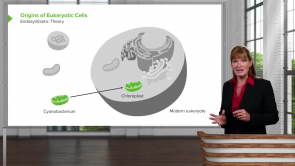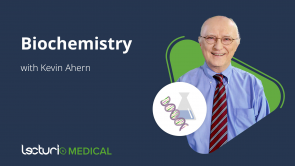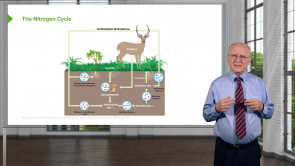Heme Synthesis

About the Lecture
The lecture Heme Synthesis by Kevin Ahern, PhD is from the course Amino Acid Metabolism.
Included Quiz Questions
Which of the following is true regarding the synthesis of heme?
- It starts with glycine and succinyl-CoA.
- It begins with a cytoplasmic enzyme.
- It begins with the incorporation of carbon dioxide.
- It begins with acetyl-CoA and glutamate.
- The first step is catalyzed by aminolevulinic acid decarboxylase.
Which of the following is true regarding the synthesis of porphobilinogen?
- Two glycines and two succinyl-CoAs would be required.
- A ring structure is destroyed.
- The enzyme is actually stimulated by heavy metals.
- Its formation requires decarboxylation.
- Porphobilinogen synthase is sensitive to cobalt ions.
Which of the following is true regarding the synthesis of hydroxymethylbilane?
- Ammonia is released during this process.
- Six glycines and six succinyl-CoAs would be required.
- Increased production results in a type of porphyria.
- A ferrous ion is inserted into its center immediately after it is synthesized.
Which of the following is true regarding uroporphyrinogen III?
- It is the first cyclic intermediate in heme synthesis.
- Its synthesis requires addition of water.
- It is found in excess in the condition of congenital erythropoietic porphyria.
- It is slowly converted to coproporphyrinogen III.
Which of the following is true regarding uroporphoryinogen III decarboxylase?
- It has the highest rate of catalysis of any known enzyme.
- It decarboxylates coproporphyrinogen III.
- It is a methodical enzyme, working very slowly.
- It requires four carbon dioxide molecules in the reaction it catalyzes.
Which of the following is true regarding the synthesis of protoporphyrinogen IX?
- The enzyme catalyzing its formation is in the mitochondrion.
- Two molecules of coproporphyrinogen III are consumed during its synthesis.
- The enzyme uses magnesium in catalysis.
- 2 molecules of oxygen are produced in the oxidative decarboxylation reaction it catalyzes.
Which of the following is not true regarding protoporphyrin IX?
- It is formed in a reduction reaction
- It is a precursor of heme and chlorophyll.
- It is ready to receive a ferrous ion into its center to form heme.
- It is formed in a reaction catalyzed by an inner mitochondrial enzyme.
Which of the following is true regarding heme?
- It requires electronic rearrangement for its final form.
- Its synthesis can start even if no iron-binding proteins are not present in the mitochondria.
- Ferrocatalase is required in the final step of its formation.
- It is formed as heme C and other hemes are made from it.
These courses may be of interest to you
Customer reviews
5,0 of 5 stars
| 5 Stars |
|
2 |
| 4 Stars |
|
0 |
| 3 Stars |
|
0 |
| 2 Stars |
|
0 |
| 1 Star |
|
0 |
it is really amazing lecture & has been organized well thank you
Thank you very much! Those extraordinarily awesome questions help me better understand the whole thing with details!






